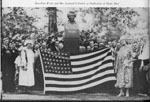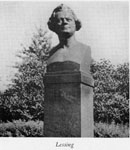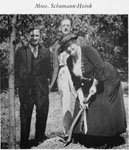The German Cultural Garden, third in historical order in the chain, extends
from the upper to the lower levels of East Boulevard. With its fountain and
stone walks and double lateral sections of linden alleys, it centers about an
impressive bronze two-figure statue of Johann Wolfgang Goethe (1749-1832) and
Friedrich von Schiller (1759-1805), Germany's greatest two poet-philosophers.
It is a replica of the famous Weimar statue, modeled in 1856 by Ernest
Reitschal, the Dresden sculptor. Here tower the two mighty figures, joined in
friendship as they were in life, and grandly dominate the spacious and
imposing German Garden. The garden is entered at the upper Boulevard level
through a triple-arched ornamental iron gate.
At the far end of the left lateral section is a bronze bust, a replica of
the bust in Leipzig, modeled by Seffner, of Gotthold Ephraim Lessing
(1729-1781), German critic and dramatist. At the far end of the right lateral
section is a bronze bust of Heinrich Heine (1797-1856), world-famous poet and
journalist of German birth. It is the work of K. Harald Isenstein of Berlin.
The lower Boulevard section of the German Garden features a bust of Friedrich
Jahn, founder of the first German turnverein program and originator of
calisthenics.
The rare Unterburg marble fountain, dedicated in 1932, is a memorial to
Friedrich Froebel, founder of the kindergarten system it once stood in the
garden of the Archbishop of Salzburg, in Austria. More than one hundred
varieties of shrubs, hedges, and trees imported from Germany decorate the
German Garden, which was designed by Architect Herman Dercum. The linden trees
were the gift of Mrs. John Spenzer, in memory of her husband, Dr. John
Spenzer.
The German Cultural Garden Association was formed on July 26, 1929, at a
meeting at the Socialer Turn Hall. On September 9, 1929, permanent officers
were elected as follows: Miss Elsie Weitz, president Charles Wolfram,
secretary and Albert Eisele, treasurer. Presidents of the Association serving
through the years have been, in addition to Miss Weitz, Mrs. L. Schlather, Dr.
Hugo Polt (professor at Western Reserve University), and Reverend Walter
Klein, Minister of the Evangelical Reformed Church. Moving spirits and loyal
members in the German Garden movement have been Mr. Charles Wolfram, founder
and for many years president of the Cleveland Cultural Gardens Federation Mrs.
Rose Raeder, at the present writing financial secretary William H. Engelmann,
recording secretary Mrs. Gertrude Benson, vice-president Mr. and Mrs.
Engelmann, founders, charter members, and trustees
48
Miss Hedwig Wagner, Mr. Eisele, Mr. Dercum, Dr. Spenzer, Mr. Krueck, and
Mr. and Mrs. Brenne served as early trustees. Maps and models for the
projected garden were made and donated by Fred Mattmueller. The development of
the German Garden was promoted in cooperation with the Park Department of the
City of Cleveland. Funds were raised by a series of card parties, poetry
readings, song recitals, and "coffee and cake" benefits. The Jahn bust was
donated by the Socialer Turn Verein and Germania Vorwaerts Turn Verein. Since
1932 a group of women members of the German Cultural Garden Association has
been active in the garden management.
The German Cultural Garden was dedicated on June 2, 1929, as part of a
week-long celebration commemorating the Lessing-Mendelssohn Bi-centennial. The
Lessing bust was unveiled at this time, and the Goethe-Schiller statue, which
formerly had stood in Wade Park, was rededicated in its new place of honor in
the German Garden.
Musical selections were rendered by the Glenville and East High School
Bands and the Vereinigte Mannerchor of Cleveland. The opening address was by
William R. Hopkins, City Manager of Cleveland. The Lessing bust was presented
to the city by Mrs. L. Schlather, chairman, and Miss Elsie Weitz, associate
chairman of the Permanent Memorials Committee. The bust was accepted on behalf
of the city by Mayor John Marshall. Professor R. W. Deering of Western Reserve
University delivered the address on Lessing. Rabbi Abba Hillel Silver
delivered the address on Moses Mendelssohn. The Star Spangled Banner was then
played by the Consolidated Bands, while the American flag was unfurled, and a
wreath was placed on the Lessing bust by Mr. David Jankau. The assemblage then
marched to the Hebrew Garden, where a wreath was placed on the Moses
Mendelssohn tablet by Mr. Ernest Mueller.
It was fitting that the bi-centennial tribute to these two great men who
inspired and befriended each other in life, should have been jointly
celebrated. Moses Mendelssohn, scholar and philosopher, was the prototype for
Lessing's stirring drama, "Nathan the Wise."
The Lessing-Mendelssohn Bi-centennial Commission consisted of William R.
Hopkins, honorary chairman Carl D. Friebolin, general chairman Leo Weidenthal
and Charles J. Wolfram, vice chairmen

Miss Elsie Weitz and Mrs. Leonard
Scholather at Dedication of Heine Bust
49

Lessing
Carl Raid, treasurer. Charles Wolfram served as chairman of the executive
committee Mrs. L. Schlather and Miss Elsie Weitz as chairman and associate
chairman, respectively, of the Committee on Permanent Memorials. Samuel Newman
was chairman of the Park Celebration Committee Lewis Drucker, director of
publicity Edward J. Schweid, general secretary Dr. E. B. De Sauze and A. H.
Friedland, chairman and associate chairman respectively of the School
Committee Mrs. Jennie K. Zwick, chairman of the Speakers' Committee Linda A.
Eastman, chairman of the Library Committee and Conrad Krueck and Charles De
Harrack, chairman and associate chairman respectively of the Music Committee.
Carl D. Friebolin was chairman of the German Garden dedication program.
A long list of enthusiastic members and sponsors also contributed to the
inspiring success of the Cleveland Lessing-Mendelssohn Bi-centennial, which
was dedicated in the spirit of the men it honored to good will and tolerance.
Because of the significance of its German Cultural Garden undertaking, the
Lessing-Mendelssohn Bi-centennial Commission was chosen by the Charles
Eisenman Award Committee to receive the Eisenman Award for 1929. The award of
$500 was contributed for the further development of the German Garden.
The Father Jahn bust was dedicated on May 1, 1931.
The Heine bust was unveiled and presented to the City of Cleveland by
William R. Hopkins and accepted by Mayor John D. Marshall, on June
14th, 1931, on the 75th anniversary of the death of the
poet. Musical setting of Heine's poems were rendered by the Cleveland
Vereinigte Saenger. Principal addresses were by Professor Ernst Feise, of
Johns Hopkins University, and Rabbi Barnett R. Brickner of the Euclid Avenue
Temple. The ceremony concluded with the singing of America by all present. The
sponsoring executive committee of the Heine Memorial Commission consisted of
William R. Hopkins, chairman Dr. Robert E. Vinson, Miss Linda A. Eastman and
R. G. Jones, vice chairmen Carl Raid, treasurer Jennie K. Zwick, secretary and
Carl D. Friebolin, Alfred A. Benesch, Miss Elsie Weitz, Leo Weidenthal,
Charles J. Wolfram, Charles De Harrack, C. R. Brenne, Albert Eisele, Professor
E. B. De Sauze, Max E. Meisel, Fred G. Folberth, Miss Mildred Chadsey, and
Clarence S. Metcalf.
Guests of honor who have planted trees in the German Garden have included
Graf Von Luckner, on April 21, 1931, and Madame Schumann-Heink, on September
7, 1933.
The purpose of the German Cultural Garden Association as set forth in
Article II of its constitution, was to 'awaken by honest and broad study,
investigation and promulgation of the underlying principles of German
Literature, Art, Science, and Culture, past and present, and thereby exemplify
and emphasize their cultural value as contributions to mankind."
The aims of the Association, thus stated, have been generously
fulfilled.

Mme. Schumann-Heink
|
Previous
| Table of
Contents | Next
|